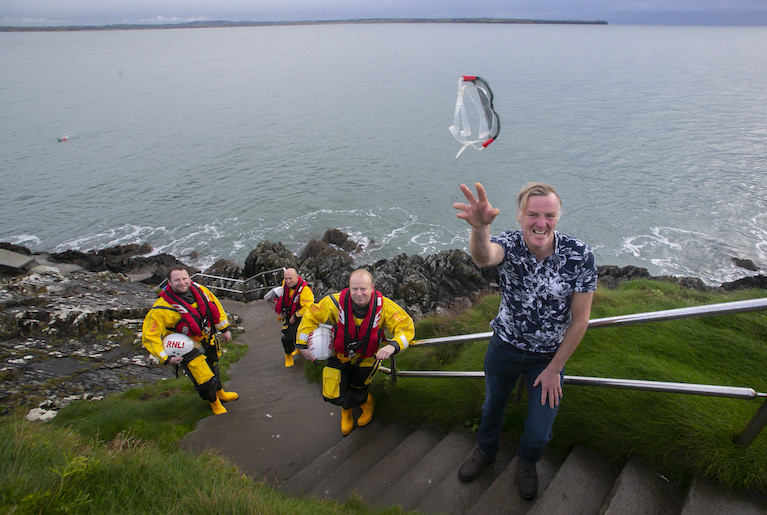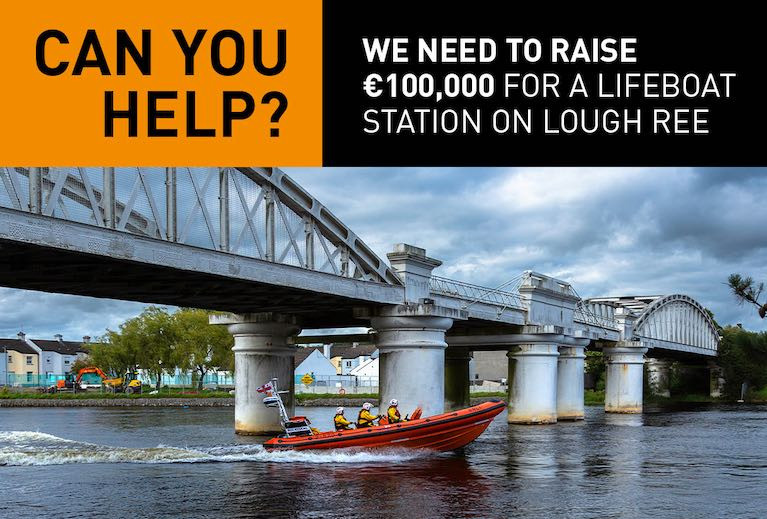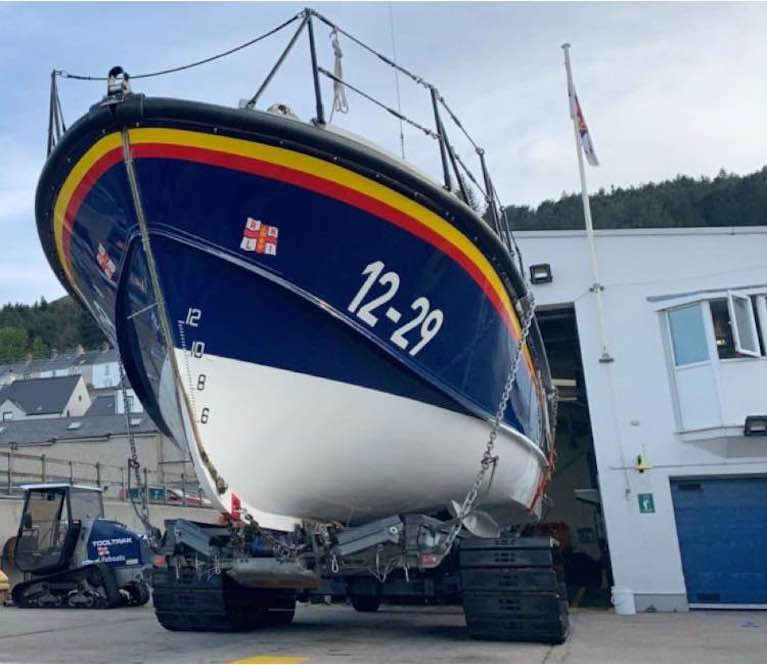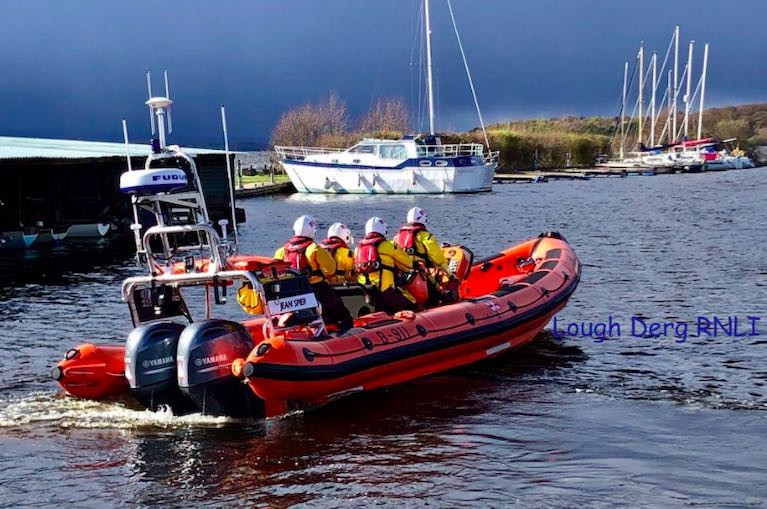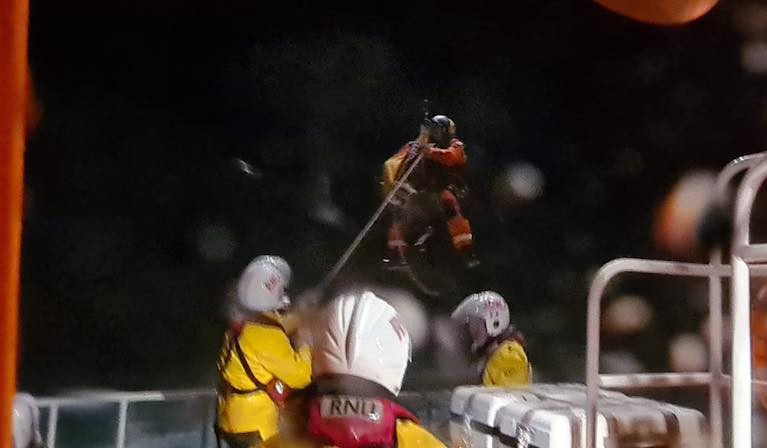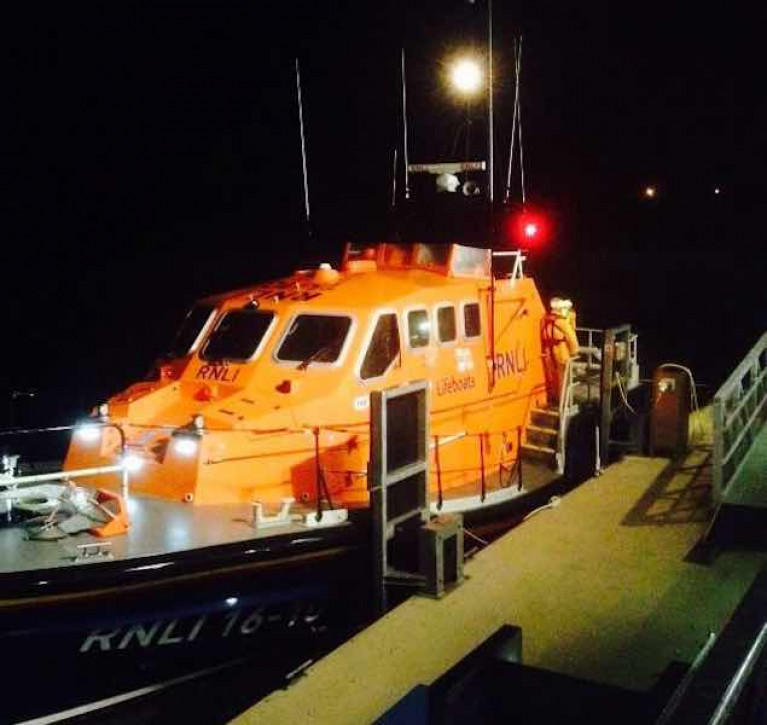Displaying items by tag: Lifeboat
Survivor Backs RNLI Christmas Appeal After Charity Sees Traditional Fundraisers Cancelled
A man whose life was saved by the RNLI off the Waterford coast earlier this year, has urged people to support the RNLI’s Christmas appeal. Michael Power from Tramore had been sea swimming when he got into serious difficulty. Pulled unconscious from the water by Tramore RNLI, the lifeboat crew never gave up on him and despite his family being called to his bedside to say goodbye, Michael went on to make a full recovery. Now in thanks to the volunteer lifeboat crew that saved his life, Michael is calling on people to support his lifesavers after the RNLI have seen a drop in income as traditional fundraising activities had to be cancelled due to the pandemic.
In January this year, Michael Power set off for a swim along the Guillamene cove in Tramore, County Waterford. A regular swimmer Michael kept his head down and was aware of other swimmers in the vicinity. Not keeping an eye as he usually did on the coastline, he eventually became aware that he was not moving even after increasing his strokes. He had become caught in a rip current and could not get out of it. He tried to get to safety, but he was rapidly losing energy and began to panic. Michael subsequently learned that he had developed Hypothermia before slipping into a coma. He has no memory of the man who raised the alarm from the shore or the RNLI lifeboat crew who were on scene minutes later to find him face down in the water and unresponsive. Onlookers from the cliff watched in shock as the volunteer crew pulled him lifeless from the water and commenced CPR. His next memory is waking up in hospital with his family having been called in to say goodbye.
Now Michael wants to thank his rescuers by calling on people to support the RNLI’s Christmas appeal and donate to the charity that saves lives at sea and on inland waters. Michael has also been down to the lifeboat station to thank his rescuers in person, along with his grateful family.
Commenting on his near-drowning Michael said, ‘I am known as the miracle man around here now. I am so grateful to my rescuers and that I am here to be able to tell my story. I know the lifeboat crew who rescued me personally, as I live locally and swim in the sea regularly, so I can only imagine how difficult it was for them to pull me out of the sea in that condition. The doctors told me that I should not have survived, and that the lifeboat crew undoubtedly saved my life. So, this is my way of saying thank you.’
‘When I visited the lifeboat station, they presented me with my swimming cap and googles that they had kept safe, unsure if I would survive but unwilling to dispose of them. It was an extremely emotional moment and I have plans to frame them as a reminder of that day that I can’t even remember. I know there are so many families out there who have reason to be grateful to the RNLI and mine certainly have, they are tremendous people.’
The RNLI have launched their Christmas appeal this year as so many traditional community fundraising events such as raft races, open days and sea swims have had to be cancelled due to the coronavirus restrictions. This year the charity has spent funds on PPE, including face masks, gloves and thousands of litres of hand sanitiser. This is money the charity hadn’t budgeted for but needed to be spent to keep its lifesavers and the public protected during the coronavirus crisis.
Lough Ree RNLI Looking to Raise €100k for New Base at Coosan Point
Coosan Point on Lough Ree is home to one of Ireland’s busiest lifeboat crews. But they operate from temporary facilities and the RNLI say they urgently need a permanent, new base to continue their lifesaving missions.
The Institute is seeking donations to help fund a new, purpose-built lifeboat station and are aiming to raise €100k.
Lough Ree volunteer crews have been rescuing people from the lake’s 28km stretch of inland water since 2012, launching more than 370 times and helping over 1,060 people.
The permanent station near the existing slipway at Coosan Point – crucial for the efficient launching and recovery of the lifeboat will include
- Secure boathouse for lifeboat, launch tractor and trailer
- Crew training and meeting rooms
- Changing facilities, showers and WCs
- Offices and operations room
- Workshop and fuel storage facilities
RNLI Appeal to Walkers Not to Try to Swim Ashore if Caught by Tide After Galway Rescue
Galway RNLI's deputy launching authority (DLA) has appealed to people not to try to swim ashore if caught in a tidal situation while walking.
Paul Carey, DLA at the Galway station, issued his appeal after the rescue of a man and a woman who were caught by spring tides in Galway on Sunday evening.
The two had walked out to Seaweed Point between Blackrock and Silverstrand which is accessed at low tide.
The spring tide took them by surprise and submerged their access back, according to the station.
Galway RNLI lifeboat launched at the request of the Irish Coast Guard at 4.43pm after the alarm was raised by a member of the public.
"Unaware that the lifeboat was on its way, one of the two took the decision to swim ashore to call for help," the station says.
"He was met at the shore by a member of the lifeboat shorecrew and confirmed there was another person still stranded, which was relayed to the lifeboat.
"Upon arrival, a lifeboat crew member searched the area, located the other casualty who was sheltering from the winds, and took her onboard the lifeboat.
"Both were brought back to the lifeboat station at Galway docks where they were assessed. They did not require medical attention," the station says.
“We would never recommend anyone to attempt to swim ashore," Mr Carey said afterwards.
"If people do get caught in circumstances like this they should remain on land and not attempt to swim ashore until the rescue services arrive," he advised.
The Galway RNLI helmsman Dave Badger was with crew Brian Niland, Dave McGrath and Ross Forde on the callout.
RNLI Newcastle locates Missing Swimmer in Dundrum Bay (Updated)
Just three days after the return of Newcastle RNLI station's D class lifeboat, Eliza, after a refit, in the late afternoon yesterday, Belfast Coastguard requested the immediate launch of the both the station's Lifeboats to reports of an overdue swimmer in the vicinity of the Inner Dundrum Bay area at at Murlough Beach.
The swimmer had got separated from his friend. Coastguard teams from Newcastle, Kilkeel and Portaferry, police officers from Newcastle and Downpatrick and the Coastguard helicopter from Valley, in Wales were also involved in the search.
Dundrum Outer Bay lies east of Newcastle in south County Down. The Outer Bay is a wide gently shelving bay, and the Inner Bay is an estuarine lagoon, connected to the Outer Bay by a tidal channel.
The search extended from Murlough Beach, around Dundrum inner bay to Tyrella Beach in difficult conditions with a strong, cold onshore wind.
Over two hours after he went missing the swimmer was found by Police Officers on the beach at Ballykinler Army Base, having been swept away from Murlough and across the bay before coming ashore. The man was taken to hospital.
The rescue was coordinated by Belfast Coastguard Operations Centre.
This story was updated on November 17 with up to date details of the rescue operation
Lough Derg RNLI Feature on BBC TV Series 'Saving Lives at Sea'
The volunteer lifeboat crew at Lough Derg RNLI will be taking to the small screen again on Tuesday 17 November at 8 pm, as they feature in the seventh episode of the BBC TV series Saving Lives at Sea.
Real-life rescue footage captured on their helmet cameras gives a frontline view of how the charity’s lifesavers risk their own lives as they go to the aid of those in danger at sea and strive to save everyone.
Now in its fifth series, the 10-part documentary showcases the lifesaving work of the RNLI’s volunteer lifeboat crews and lifeguards from around Ireland and the UK. The series will air on BBC Two on Tuesdays at 8 pm, as well as being available on BBC iPlayer following broadcast.
Real rescue footage is accompanied by interviews from the volunteer lifeboat crews and lifeguards alongside the people they rescue and their families.
In a forthcoming episode, to be aired on Tuesday 17 November at 8 pm on BBC Two, viewers will see Lough Derg RNLI rescue two kayakers who got into extreme difficulty in rough weather, alongside rescue stories from their colleagues at other stations and beaches around our coasts.
Owen Cavanagh, Helm of the Lough Derg RNLI lifeboat crew featured in the 17 November episode, says: ‘It’s great that with the Saving Lives at Sea programme our supporters can see what we do out on a Shout, and from the comfort of their own home too. This year the pandemic has presented RNLI volunteers with additional challenges, but we’ve continued to maintain a 24/7 search and rescue service. And due to Covid19, fundraising events have been cancelled, with a drop in our charitable income. Without the generous support and donations from the public, we wouldn’t be able to save lives at sea. We need their support more than ever during these challenging
times.’
During 2019, RNLI lifeboat crews around Ireland and the UK rescued
- 9,412 people, saving 211
- lives, while the charity’s lifeguards aided
- 32,207 people and saved 118
- lives on some of the UK’s busiest beaches.
Castletownbere RNLI lifeboat was launched last night at 22:54 to go to the assistance of a seriously will fisherman on board a fishing vessel off the West Cork Coast.
Castletownbere RNLI lifeboat was tasked by Valentia Coastguard Radio at 22:46 last night to go to the assistance of a 27-metre locally-registered fishing trawler, with six persons on board, located two miles south of Mizen Head which reported that a crewman had suddenly become seriously ill.
The lifeboat was launched within minutes under the command of Coxswain Dean Hegarty and located the vessel west of Sheep’s Head.
Conditions on-scene were difficult with a three metre swell and 25-knot south-westerly winds. Two attempts were made to transfer the casualty from the fishing vessel to the lifeboat but were unsuccessful due to unfavourable conditions. The lifeboat then escorted the trawler to just inside the mouth of Castletownbere harbour where the casualty, a man in his late forties, was transferred to the lifeboat in calmer waters.
 The Coastguard helicopter 115 lowered a winchman onboard the Castletownbere RNLI
The Coastguard helicopter 115 lowered a winchman onboard the Castletownbere RNLI
The Shannon-based Sikorsky Irish Coastguard helicopter Rescue 115 was tasked and met with the lifeboat in Bantry Bay. The helicopter lowered a winchman and the casualty was successfully transferred to the helicopter for immediate evacuation to Cork University Hospital.
Commenting on the callout Castletownbere RNLI Lifeboat Deputy Launching Authority, Brendan O’Neill, complimented the crew on its rapid response to the call-out and thanked the coastguard for its cooperation in making this call-out successful.
Coastguard & Lifeboats Assisting Drifting Cargo Vessel off Waterford
In a major mobilisation of rescue services off the south-east coast this evening, the Irish Coast Guard is coordinating assistance being provided to a cargo vessel that has lost power off the Waterford Harbour.
The Coast Guard said in a statement this evening, The ship, which is carrying a cargo of coal reported to MRCC Dublin earlier this afternoon that it had lost power.
RNLI Lifeboats from Dunmore East, Kilmore Quay and Rosslare, as well as the Waterford based Coast Guard Helicopter and Fethard Coast Guard unit, were immediately tasked. A Waterford based tug is expected on scene shortly after 6 pm.
 The track of the 99-metre ship which was on its way to New Ross from Germany when it lost power off the Waterford coast.
The track of the 99-metre ship which was on its way to New Ross from Germany when it lost power off the Waterford coast.
The Coast Guard has described the situation as stable and the vessel with Lifeboat assistance is drifting in an Easterly direction pending arrival of the Tug.
More news on this as it becomes available
Baltimore RNLI in Medical Evacuation from Sherkin Island
Baltimore RNLI was called out to provide a medical evacuation late last night (Sunday 18 October) from Sherkin Island off the coast of Baltimore, West Cork.
The volunteer lifeboat crew launched their all-weather lifeboat at 11.39 pm, following a request from the Irish Coast Guard to provide medical assistance and evacuation to a female who had sustained an injury to her arm.
The Baltimore all-weather lifeboat crew along with two HSE paramedics arrived at Sherkin Island pier at 11.47 pm. The voluntary lifeboat crew brought the casualty onboard the lifeboat. After an initial assessment was carried out by the HSE paramedics, a lifeboat crew member assisted in the administration of casualty care and the casualty was able to return home. The lifeboat then departed Sherkin at 00.07 am and arrived to the station in Baltimore at 00.18 am.
There were five volunteer crew onboard the lifeboat, Coxswain Kieran Cotter, Mechanic Micheal Cottrell and crew members Ronnie Carthy, Sean McCarthy and David Ryan, along with two paramedics from the HSE. Conditions in the harbour during the call out were calm with a south-easterly force 5 wind, which created heavy runs at Sherkin pier.
Galway man John Coyle has been recognised by the Queen in the Birthday Honours list for his role in helping the RNLI in its work to save lives at sea. John is to receive an OBE. A former Trustee of the RNLI and Chair of the RNLI’s Council in Ireland, John has been to the forefront of lifesaving on the island of Ireland.
A graduate in Economics and Business from University College Dublin and The College d’Europe at Bruges, John Coyle is a former President of Galway Chamber of Commerce and Chambers Ireland, also holding the position of Vice Chair of Eurochambres. John has also worked in the agrochemical, Maritime, Tourism and Property sectors.
Throughout his business career and charity work, John has been committed to the strengthening of cross border business links and mutual cooperation.
In 2008 he was nominated by the Government to the Board of the Commissioners for Irish Lights - the entity charged with the maintenance of lighthouses and AIDS to Navigation for the entire Island of Ireland.
His relationship with the RNLI was a result of a lifelong interest in yachting and began through fundraising for the lifeboats on the west coast of Ireland before joining the Irish Council of the RNLI. John was then invited to join the UK Council of The RNLI before becoming a Trustee of the charity. His direct involvement with the RNLI spans some thirty-five years and continues to this day.
In June 2019, he was appointed a Knight of the Sovereign Order of Malta and now he is to receive on OBE for his work with the charity.
Speaking on the award, John Coyle said, ‘This is a tremendous honour and one, as a volunteer for the RNLI, I feel very proud to receive. The RNLI in Ireland is an all-island organisation and the spirit of co-operation that exists between Ireland and the UK continues to bring people together in their mission to save lives. A huge debt of thanks is due to all those who so generously continue to fundraise or donate to the RNLI, we could not continue without their support.
Commenting on the honour, outgoing Chair of the RNLI’s Irish Council David Delamer added, ‘This is a wonderful tribute to John and recognition of many years of dedicated work. John is a man of great integrity and optimism. He has the great ability to be able to bring people with him and listen to what people need. He strives in all things for balance and fairness. John always works tirelessly and diligently, to help causes close to his heart, never seeking recognition but always gaining respect.
RNLI Chief Executive, Mark Dowie said: ‘It is such a delight to see these RNLI people recognised for their hard work and commitment, particularly as we have had such a challenging year. Those who have been named in this year’s Birthday Honours truly represent the RNLI values. On behalf of everyone at the RNLI, I send my heartfelt congratulations and gratitude to all those who have been recognised.’
Clifden RNLI Lifeboat Boosted By Connemara Cycling Challenge
Clifden RNLI was delighted to accept the sum of €3,774 raised by the Connemara based Twelve Bens Cycling Club after a unique and testing fundraising challenge.
On Sunday, September 6th, 12 cyclists from the club undertook an innovative cycling challenge consisting of 12 laps of the 'Sky Road' loop, so-called due to its steep hill climbs along the well known scenic route.
Beginning and ending at the Clifden Bike Shop on Market St, the cyclists completed twelve laps of the 17-kilometre route which presented a testing 230 metres of elevation per lap.
 On the Sky Road Loop at Clifden in aid of the local RNLI
On the Sky Road Loop at Clifden in aid of the local RNLI
The participating cyclists were Ciarán Hickey, Daniel King, Dara O Donoghue, Finian Sheridan, John Gallagher, John James Flaherty, Johnny King, Nick Finney, Rob King (RNLI Area Lifeboat Manager), Simon Ashe, Simon O' Hora and Willie O'Hora.
The group were joined by some support cyclists and stewards and a small outdoor gathering of socially distanced supporters to encourage them in their challenge, which they hoped to achieve in less than 12 hours.
Event organiser Simon O Hora said 'We came up with a challenge we could do locally as travelling for training wasn't an option due to Covid 19 restrictions. As a club, we wanted to do something that would push ourselves mentally and physically and one where we could see the sea on every lap-to remind us why we were doing it.
It was certainly challenging at times but ultimately it was a rewarding endeavour and we were really glad to have been able to raise this sum for the RNLI'.
 Simon O Hora of the Twelve Bens Cycling Club presents Clifden RNLI Lifeboat Operations Manager John Brittain with a cheque for €3,774
Simon O Hora of the Twelve Bens Cycling Club presents Clifden RNLI Lifeboat Operations Manager John Brittain with a cheque for €3,774
A further €520 was collected in RNLI buckets on the day and the weary cyclists fully completed their epic challenge in 10 hours and 12 minutes.
Speaking on behalf of Clifden RNLI, Catherine Pryce said 'In this most challenging year for all charities, the Twelve Bens challenge has provided a very welcome donation to the local Clifden lifeboat crew. It was an extremely well-run event, all carried out within the necessary public health guidelines and we congratulate the cyclists on their achievement and thank all who donated for their ongoing support'.



























